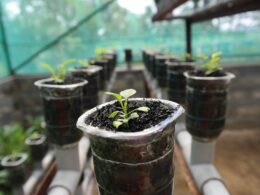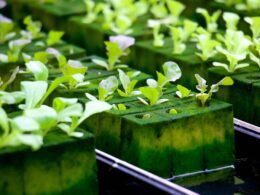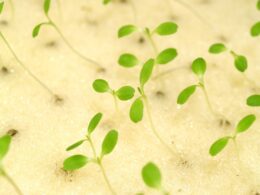If you’re new to hydroponics, you may have questions about how long your nutrient solution will last. It’s an important question because your nutrient solution is the lifeblood of your hydroponic system. Without the right nutrients, your plants won’t thrive, and your investment will be wasted.
The good news is that hydroponic nutrients can last for quite some time if you take proper care of them. In this article, we’ll explore the factors that affect the lifespan of your nutrient solution, signs that it’s time to replace your solution, and best practices for maintaining your hydroponic nutrient solution.
By the end of this article, you’ll have a better understanding of how long your nutrient solution can last and how to keep your hydroponic system healthy.
Understanding the Lifespan of Hydroponic Nutrients
You’re probably wondering how often you’ll need to replace your hydroponic nutrient solution to ensure your plants are getting the best possible nutrients for optimal growth – it’s crucial to stay on top of this if you want to see your plants thrive!
The lifespan of hydroponic nutrients is affected by two main factors: nutrient storage and nutrient degradation.
Nutrient storage refers to how you store your nutrients. It’s important to store them properly, making sure they are sealed tightly and kept in a cool, dry place. If not stored correctly, the nutrients can become contaminated and lose their potency, which will affect their lifespan. It’s also essential to follow the manufacturer’s instructions for mixing and application to ensure maximum efficacy.
Nutrient degradation is another crucial factor that affects the lifespan of hydroponic nutrients. Nutrients can degrade over time, especially if they are exposed to light, heat, or oxygen. This degradation can lead to a decline in nutrient quality, which will result in poor plant growth.
It’s recommended to replace your nutrient solution every two to three weeks to ensure that your plants are getting the best possible nutrients for optimal growth.
In conclusion, understanding the lifespan of hydroponic nutrients is essential in ensuring that your plants are getting the best possible nutrients for optimal growth. By properly storing your nutrients and staying on top of nutrient degradation, you can extend the lifespan of your nutrient solution and see your plants thrive. Remember to follow the manufacturer’s instructions for mixing and application and replace your nutrient solution every two to three weeks for maximum efficacy.
Factors That Affect the Lifespan of Hydroponic Nutrients
When it comes to the lifespan of your hydroponic nutrients, there are several factors that can affect how long they last. The type of nutrient solution you use, the quality of your water, and the temperature and pH levels of your system can all play a role in determining how quickly your nutrients will degrade. Additionally, the varieties of plants you are growing can also have an impact.
By paying attention to these key factors, you can help ensure that your hydroponic system stays healthy and productive for as long as possible.
Type of Nutrient Solution
The type of nutrient solution used in hydroponics greatly affects the growth and health of the plants. Organic and synthetic nutrient solutions have their own benefits and drawbacks.
Organic nutrient solutions are natural and can provide additional micronutrients for the plants. However, they can also be expensive and have a shorter shelf life.
On the other hand, synthetic nutrient solutions are more affordable and have a longer shelf life. However, they may not provide the same level of micronutrients as organic solutions.
When choosing a nutrient solution for your hydroponic system, consider the DIY recipes available online. These recipes offer a cost-effective solution for those who want to create their own nutrient solution. Additionally, you can customize the solution to meet the specific needs of your plants. However, be sure to follow the recipe carefully to avoid damaging your plants.
Ultimately, the type of nutrient solution you choose will greatly impact the health and growth of your hydroponic plants.
Water Quality
Water quality is crucial for the success of your hydroponic system, as it directly affects the absorption of nutrients by your plants and ultimately their growth and health. When it comes to hydroponic gardening, water quality is just as important as the type of nutrient solution you use.
The quality of the water you use can impact the pH balance of the solution and the overall health of your plants. One method of ensuring good water quality is through water filtration. Filtration can remove impurities in the water that can negatively affect the nutrient solution and plant growth.
By using a filtration system, you can remove chlorine, heavy metals, and other contaminants that can hinder nutrient absorption. By paying attention to water quality and investing in a filtration system, you can ensure the best possible growth and yield for your hydroponic garden.
Temperature and pH Levels
Maintaining proper temperature and pH levels is key to creating a thriving hydroponic garden, as it’s like finding the sweet spot for your plants to flourish.
The optimal temperature for hydroponic plants is usually between 65-75°F. If the temperature goes above or below this range, the growth rate of the plants may be affected. Overheating can cause the plants to wilt, while cold temperatures can slow down the growth rate.
PH level management is also crucial for hydroponic gardening. The ideal pH range for hydroponic plants is between 5.5-6.5. If the pH level is too high or too low, it can lead to nutrient deficiencies or toxicities, which can harm the plants.
Regular testing and adjustment of the pH level is necessary to ensure a healthy hydroponic garden. With proper temperature and pH level management, you can create a thriving hydroponic garden that will yield a bountiful harvest.
Plant Varieties
Get ready to explore the exciting world of plant varieties in hydroponic gardening! When it comes to choosing the right plants for your hydroponic system, there are a few things to keep in mind.
One of the most important factors is the nutrient requirements of each plant. Some plants require more nitrogen, while others need higher levels of phosphorus or potassium. Understanding the specific needs of each plant will allow you to choose the right nutrient solution and ensure healthy growth.
Another important factor to consider is the yield potential of each plant. Some plants, like tomatoes and peppers, have high yield potential and can produce a large number of fruits or vegetables per plant. Others, like herbs and leafy greens, may have lower yield potential but can be grown in larger quantities.
By choosing the right plant varieties for your hydroponic system, you can maximize your yield and get the most out of your nutrient solution. Remember to research each plant’s specific nutrient requirements and yield potential before making your selection.
Can I Start Hydroponics Without Using Nutrients?
Starting hydroponics without using nutrients is not recommended. Nutrients are essential for providing plants with proper nutrition, as they cannot get it from soil. Without nutrients, plants will struggle to grow and survive. To ensure successful hydroponics, it is crucial to use a nutrient solution specifically designed for hydroponic systems to support healthy plant growth.
Signs That Your Nutrient Solution Needs Replacing
If you’re noticing deficiencies in your plants’ growth or discoloration in the leaves, it may be time to consider replacing your nutrient solution. Plants require a balanced nutrient solution to grow properly, and if they’re not receiving the right amount of nutrients, they can suffer.
One way to tell if your nutrient solution is off is by testing the pH level. If the pH is too high or too low, it can affect the way your plants absorb nutrients.
Another sign that your nutrient solution needs replacing is if there is an excess of salt buildup. When you add nutrients to your water, the salts can build up over time and create a toxic environment for your plants. This can lead to burning of the roots and stunted growth.
To avoid this, it’s important to flush your system regularly and replace your nutrient solution every few weeks.
In addition to pH levels and salt buildup, you should also pay attention to the color of your nutrient solution. If it’s cloudy or has a foul odor, it’s a sign that bacteria or other harmful microorganisms have started to grow. This can lead to root rot and other diseases, so it’s important to replace your nutrient solution immediately.
By keeping a close eye on your plants and their nutrient solution, you can ensure that they’re getting the nutrients they need to thrive.
How to Replace Your Hydroponic Nutrient Solution
Ready to give your plants a nutrient boost? Here’s how to easily replace your hydroponic nutrient solution and keep your plants thriving!
Choosing the right nutrients is key to ensuring your plants receive the necessary vitamins and minerals for optimal growth. There are many options available, including pre-made nutrient solutions and DIY mixtures. Whichever option you choose, be sure to follow the instructions carefully and stay within the recommended dosage.
Once you’ve chosen your nutrients, it’s time to replace your old solution. First, drain your hydroponic system completely and discard any remaining solution. Next, rinse the system thoroughly with clean water to remove any leftover residue. Finally, mix your new nutrient solution according to the instructions and fill your system with the fresh solution.
Remember to monitor your plants closely and adjust the nutrient levels as needed. Replacing your hydroponic nutrient solution may seem daunting, but it’s essential for maintaining healthy plants. By choosing the right nutrients and following these easy steps, you can ensure your plants receive the necessary vitamins and minerals for optimal growth.
So go ahead, give your plants the boost they need and watch them thrive! Imagine the satisfaction of seeing your plants grow faster and healthier than ever before! Don’t let old, depleted nutrient solution stunt your plant’s growth – give them the fresh nutrients they deserve! With just a few simple steps, you can ensure your hydroponic system is always running at its best!
Best Practices for Maintaining Your Hydroponic Nutrient Solution
Maintaining your hydroponic nutrient solution is essential for ensuring your plants continue to thrive, so let’s dive into the best practices for keeping your nutrient solution fresh and effective! Two important aspects of maintaining your nutrient solution are pH maintenance and nutrient dosing. Keeping the pH level of your nutrient solution between 5.5 to 6.5 is crucial for nutrient uptake by your plants. You can use pH testing kits or meters to measure the level of your solution and adjust it accordingly using pH up or down solutions.
When it comes to nutrient dosing, it’s important to follow the manufacturer’s instructions carefully. Overdosing or underdosing can have negative effects on your plants’ growth. Keeping track of the amount of nutrients you add to your solution and the frequency of adding them is also important. A common method is to add nutrients every week, but this can vary depending on the plant species and growth stage. You can use a nutrient calculator to determine the ideal amount and frequency of nutrient dosing for your plants.
In addition to pH maintenance and nutrient dosing, regularly changing your nutrient solution is also important. As a general rule, you should change your solution every 2-3 weeks to avoid nutrient buildup and maintain a healthy balance of nutrients. By following these best practices, you can ensure that your hydroponic nutrient solution stays fresh and effective, providing your plants with the optimal nutrients they need for healthy growth.
| Best Practices for Maintaining Your Hydroponic Nutrient Solution | |
|---|---|
| 1. pH maintenance | Keep the pH level of your nutrient solution between 5.5 to 6.5 for optimal nutrient uptake by your plants. Use pH testing kits or meters to measure the level of your solution and adjust it accordingly using pH up or down solutions. |
| 2. Nutrient dosing | Follow the manufacturer’s instructions carefully to avoid overdosing or underdosing. Keep track of the amount of nutrients you add to your solution and the frequency of adding them. Use a nutrient calculator to determine the ideal amount and frequency of nutrient dosing for your plants. |
| 3. Regularly changing your nutrient solution | Change your solution every 2-3 weeks to avoid nutrient buildup and maintain a healthy balance of nutrients. |
Frequently Asked Questions
Can I reuse old nutrient solution in my hydroponic system?
Are you considering reusing old nutrient solution in your hydroponic system? While there are benefits to this practice, there are also drawbacks to keep in mind.
Reusing nutrients can save you money and reduce waste, but it can also lead to imbalances in your plants’ nutrient intake. Additionally, recycling water can have an environmental impact if not done properly.
It’s important to monitor your nutrient solution’s pH and nutrient levels closely if you choose to reuse it and to properly dispose of any excess solution to prevent contamination.
Ultimately, the decision to reuse nutrient solution should be based on careful consideration of the potential benefits and drawbacks.
How often should I check the pH level of my nutrient solution?
When it comes to maintaining a healthy hydroponic system, checking the pH level of your nutrient solution is crucial. The optimal pH range for most plants is between 5.5 and 6.5, so it’s important to regularly test your solution and make any necessary adjustments.
There are a few different pH testing methods available, including test strips and pH meters. pH fluctuations can have a significant impact on plant growth, so it’s important to keep your solution within the optimal range.
If the pH level is too high or too low, it can affect nutrient uptake and cause nutrient deficiencies or toxicities. By regularly monitoring and adjusting your pH levels, you can ensure that your plants are getting the nutrients they need to thrive.
Is it necessary to use different nutrient solutions for different stages of plant growth?
To ensure optimal plant growth, it’s essential to provide the right nutrients at the right time. Different stages of plant growth require different plant nutrition requirements. Therefore, it’s necessary to use different nutrient solutions to meet these needs.
Using the same nutrient solution throughout the plant’s life cycle can lead to nutrient deficiency symptoms, such as yellowing leaves, stunted growth, and poor fruit production. It’s crucial to monitor your plants carefully and adjust your nutrient solution accordingly.
Keep a close eye on your plants and look out for any signs of nutrient deficiency, so you can provide the necessary adjustments promptly. By doing so, you can ensure your plants receive the best possible care and reach their full potential.
Can I mix different brands of hydroponic nutrients together?
When it comes to mixing hydroponic nutrients, it’s important to consider nutrient compatibility. Not all brands or types of nutrients can be mixed together without causing harm to your plants. It’s best to stick to one brand or line of nutrients for optimal results.
Mixing different brands can lead to imbalances in nutrient ratios and cause nutrient lockout, which can stunt plant growth or even kill your plants. So, it’s important to do your research and make sure the nutrients you want to mix are compatible before experimenting.
Remember, the safety and health of your plants should always come first.
How do I dispose of old nutrient solution safely?
To dispose of old nutrient solution safely, you need to consider the environmental impact. First, you shouldn’t pour it down the drain or into your garden, as it can contaminate the soil and water supply. Instead, you can find a local hazardous waste facility that accepts liquid waste or contact a professional waste disposal company.
It’s important to follow all safety guidelines when handling and transporting the solution, such as wearing protective gear and properly labeling the container. By disposing of your old nutrient solution safely, you’re protecting both the environment and your community from potential harm.
Conclusion
Now that you know how to maintain your hydroponic nutrient solution, it’s important to understand how long it lasts. The lifespan of your nutrient solution depends on several factors including the type of nutrients used, the quality of water, and the plant’s growth stage.
However, generally speaking, nutrient solutions can last anywhere from one to two weeks. It’s important to keep an eye on your nutrient solution and look out for signs that it needs to be replaced, such as changes in pH or the appearance of algae.
By following best practices for maintaining your nutrient solution, you can ensure that your plants receive the proper nutrients they need for optimal growth. So, keep monitoring your solution and remember to replace it when necessary for a successful hydroponic gardening experience.








